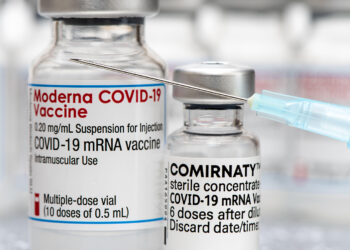Around 98 million US adults — more than 1 in 3 people — have prediabetes. The condition often presents with no symptoms — 80% of people are unaware they have it — yet, it’s not to be taken lightly: Untreated over the course of 5 years, many with prediabetes go on to develop type 2 diabetes.
“Cellular changes are already happening in prediabetes,” explained Kevin Miller, DO, board-certified family physician and member of the American Diabetes Association’s Primary Care Committee, “but I often tell patients that they are still in my ‘prevention club.’ I’m trying to protect the cells from further damage and progression.”
Mihail Zilbermint, MD, an associate professor of clinical medicine in the Division of Endocrinology, Diabetes, and Metabolism at Johns Hopkins Medicine, Baltimore, said that “we need to treat prediabetes as an actual diagnosis — not just a warning sign.” The condition, he said, marks a critical window for primary care physicians to intervene to improve health.
There are no US Food and Drug Administration (FDA)–approved medications specifically for prediabetes, and due to systemic barriers, prediabetes can be overlooked. With the right tools and systems in place, however, it can be properly addressed to prevent disease progression and improve health.
Early Intervention Matters
Anne Peters, MD, director of the University of Southern California Clinical Diabetes Programs, Los Angeles, noted that early intervention with prediabetes is key.
The landmark Diabetes Prevention Program (DPP) trial demonstrated that intensive lifestyle interventions — including diet, exercise, and weight loss — reduced type 2 diabetes incidence by 58%. In patients older than 60 years, these interventions lowered disease incidence by 71%. In comparison, metformin therapy reduced type 2 diabetes incidence by 31%.
Even delaying diabetes onset by just 4 years is linked with significantly fewer complications, including heart attack and nephropathy.
“It wasn’t until the DPP that we really showed that if you have a healthy lifestyle and/or take metformin, we can help you not progress to diabetes,” said Peters. “In many cases, people would go back to more normal glucose tolerance.”
Prediabetes is also independently associated with increased risk for all-cause mortality and both macro- and microvascular disease risk, including cardiovascular disease and chronic kidney disease. “Microvascular complications really begin long before diabetes is diagnosed,” said Zilbermint.
People with prediabetes often have other coexisting health concerns, including hypertension, abnormal cholesterol levels, sleep apnea, or gout — all worth treating, said Peters.
Barriers in Primary Care Intervention
Research suggested primary care physicians recognize the importance of highlighting prediabetes but face many systemic barriers, including time limitations, low reimbursement for preventive health counseling, a lack of FDA-approved drugs specifically targeting prediabetes, and more.
“My heart goes out to the primary care physicians; we know they don’t have enough time to address all the problems,” said Zilbermint.
Peters added that patient adherence to lifestyle interventions has always been difficult. “It’s hard to get patients motivated to adopt healthy habits, and until the recent advent of the GLP-1 [glucagon-like peptide 1] receptor agonists, it’s been hard to get people to lose weight.”
Yet even in constrained clinical environments, small interventions — such as timely screening, structured referrals, and judicious pharmacotherapy — can translate into long-term reductions in morbidity.
Implement Screening and Make a Clear Diagnosis
The US Preventive Services Task Force recommended screening for prediabetes and type 2 diabetes in adults aged 35 to 70 years who are overweight or obese; about half of eligible patients are screened in primary care settings.
Results indicating prediabetes are a fasting blood glucose of 100-125 mg/dL, a glycated hemoglobin of 5.7%-6.4%, or an oral glucose tolerance test 2-hour blood glucose of 140-199 mg/dL.
Peters said that too often, small elevations in glucose — say, a fasting blood glucose of 110 mg/dL — can get written off in primary care settings as “nothing to worry about.” However, she stressed the need to act.
Effective Counseling Techniques
Even brief conversations can prompt lifestyle changes. Miller educated patients on some of the “ominous octet,” or disruptions in normal bodily processes that contribute to the development and progression of type 2 diabetes. He used numbers as a gauge and explained prediabetes as a yellow zone. “I often tell my patients, ‘Let’s take the car in to get some work done,’” he said.
Peters encouraged providers to frame conversations about change around the present and future, noting that modest changes make an impact. For those with prediabetes, a 7% weight loss reduced the risk of developing type 2 diabetes by 58%, per the DPP. “The more someone can shift to a healthier place, the healthier they’ll be,” she said.
Electronic medical record system prompts can also help flag candidates for counseling, said Zilbermint.
Bringing Compassion to Conversations
A prediabetes diagnosis can be overwhelming. Patients may have fears around family history or a resistance to change. Approaching conversations with kindness and empathy is important. “There’s a whole psychology to diabetes,” said Peters. “Diabetes isn’t about shame or blame. Some people are genetically prone to have prediabetes, and this is a manageable issue.”
Miller tried to answer patients’ questions to steer a personalized treatment plan for long-term, sustained results.
Connecting Patients to Proven Programs
Despite evidence of their effectiveness, only 36% of primary care physicians refer patients to a diabetes prevention lifestyle change program (findable here) as their initial management approach, according to one national survey. Miller often referred patients to DPP and encouraged a follow-up visit. Zilbermint noted that health coaches offer another potential solution.
Consider Medication
The American Diabetes Association recommended considering metformin to prevent type 2 diabetes in high-risk patients with prediabetes, yet less than half of primary care physicians (43%) reported prescribing it. Weight loss medications — such as GLP-1 receptor agonists or sodium-glucose cotransporter 2 inhibitors — can treat prediabetes, too, said Peters, who noted that they can improve blood sugars and overall health.
Source link : https://www.medscape.com/viewarticle/screening-intervention-optimizing-prediabetes-care-primary-2025a1000cp0?src=rss
Author :
Publish date : 2025-05-20 11:54:00
Copyright for syndicated content belongs to the linked Source.














